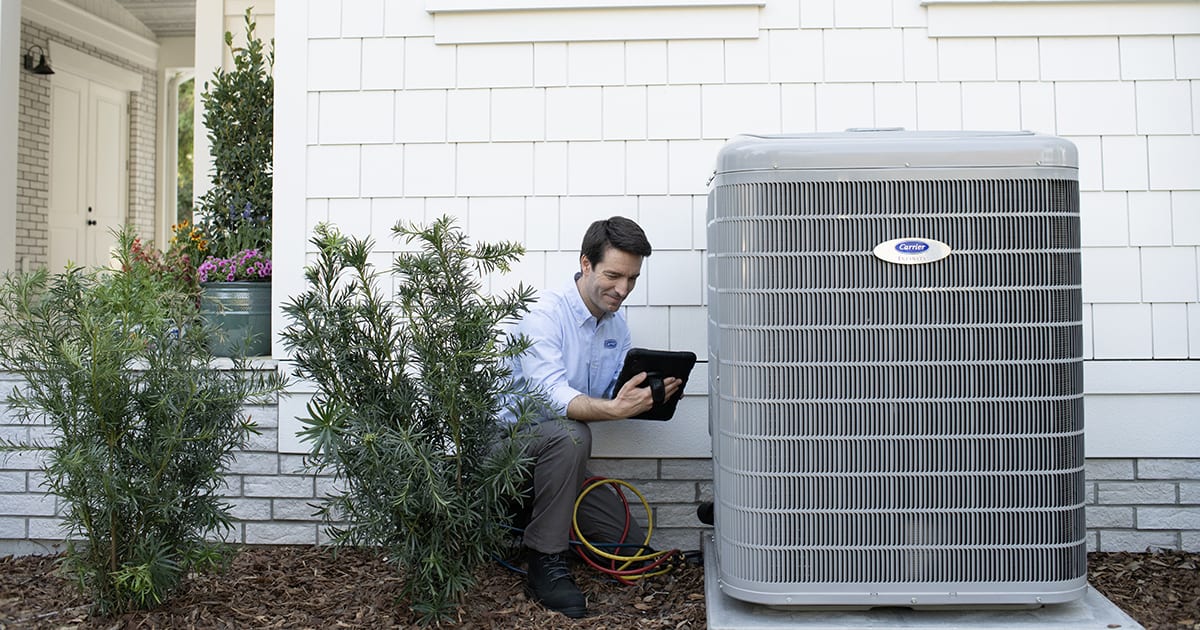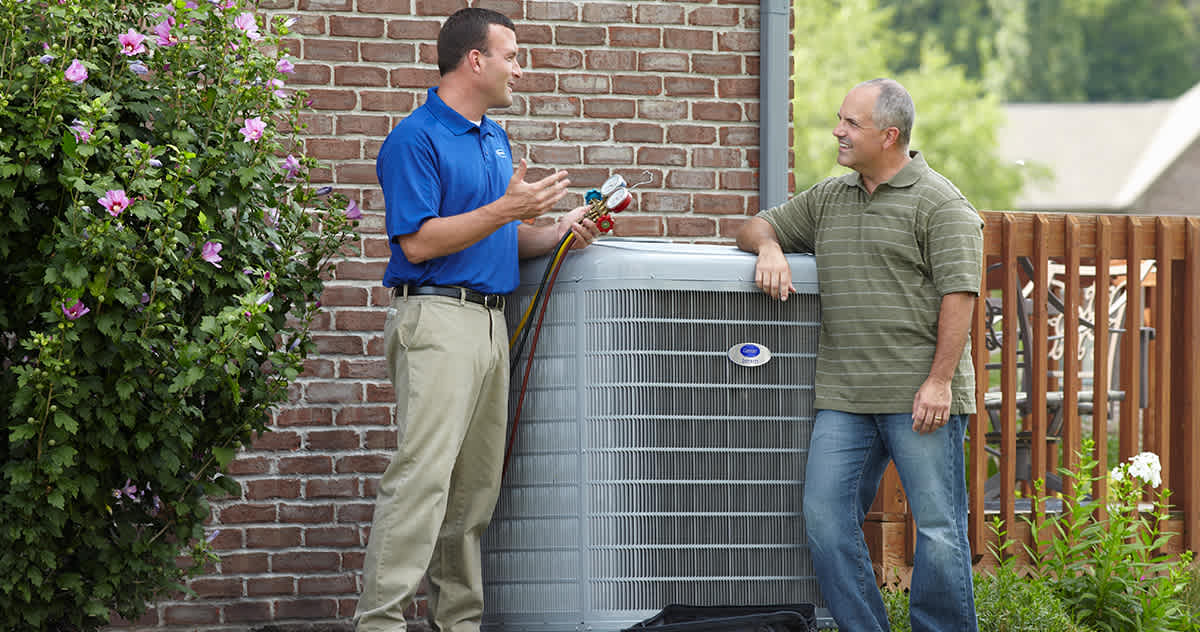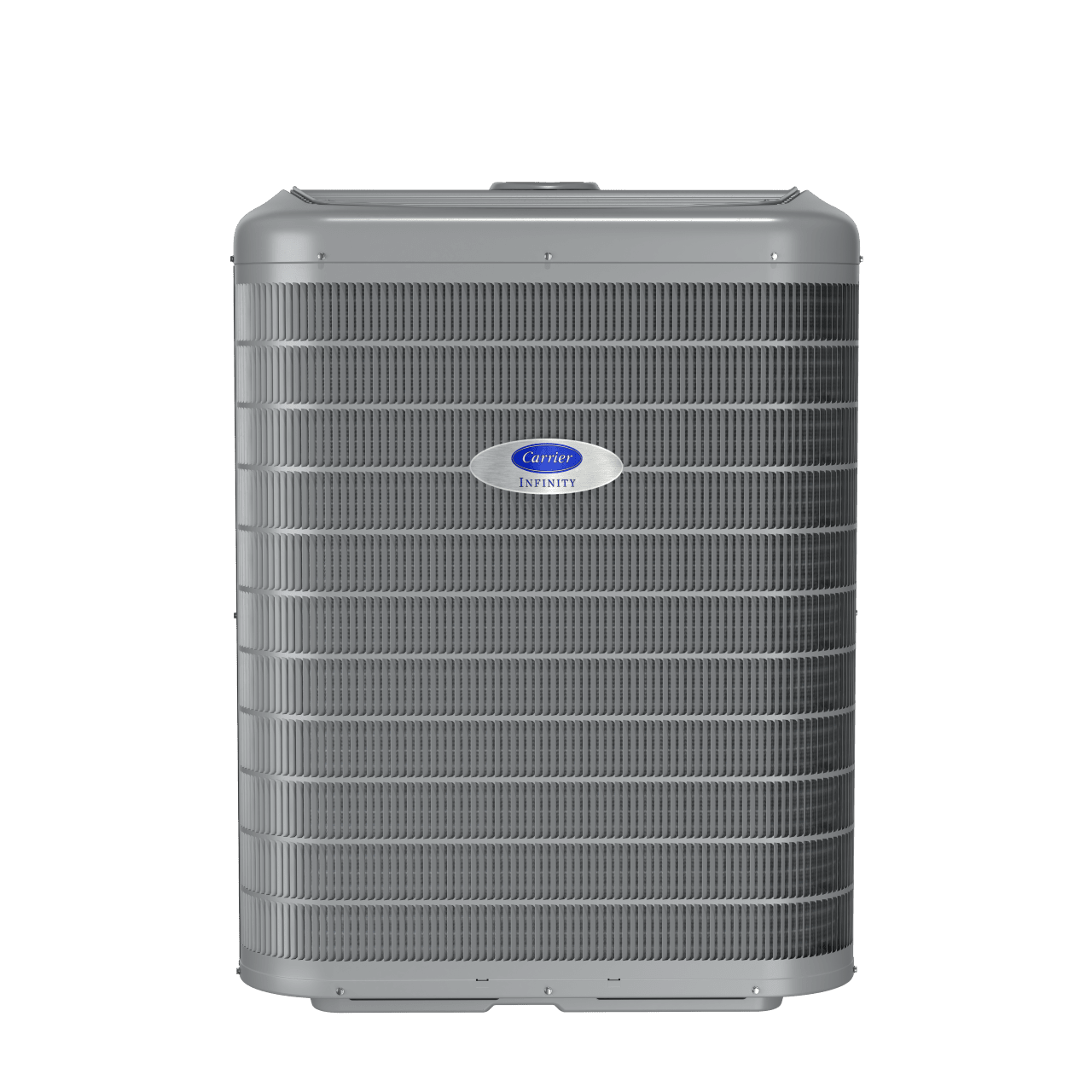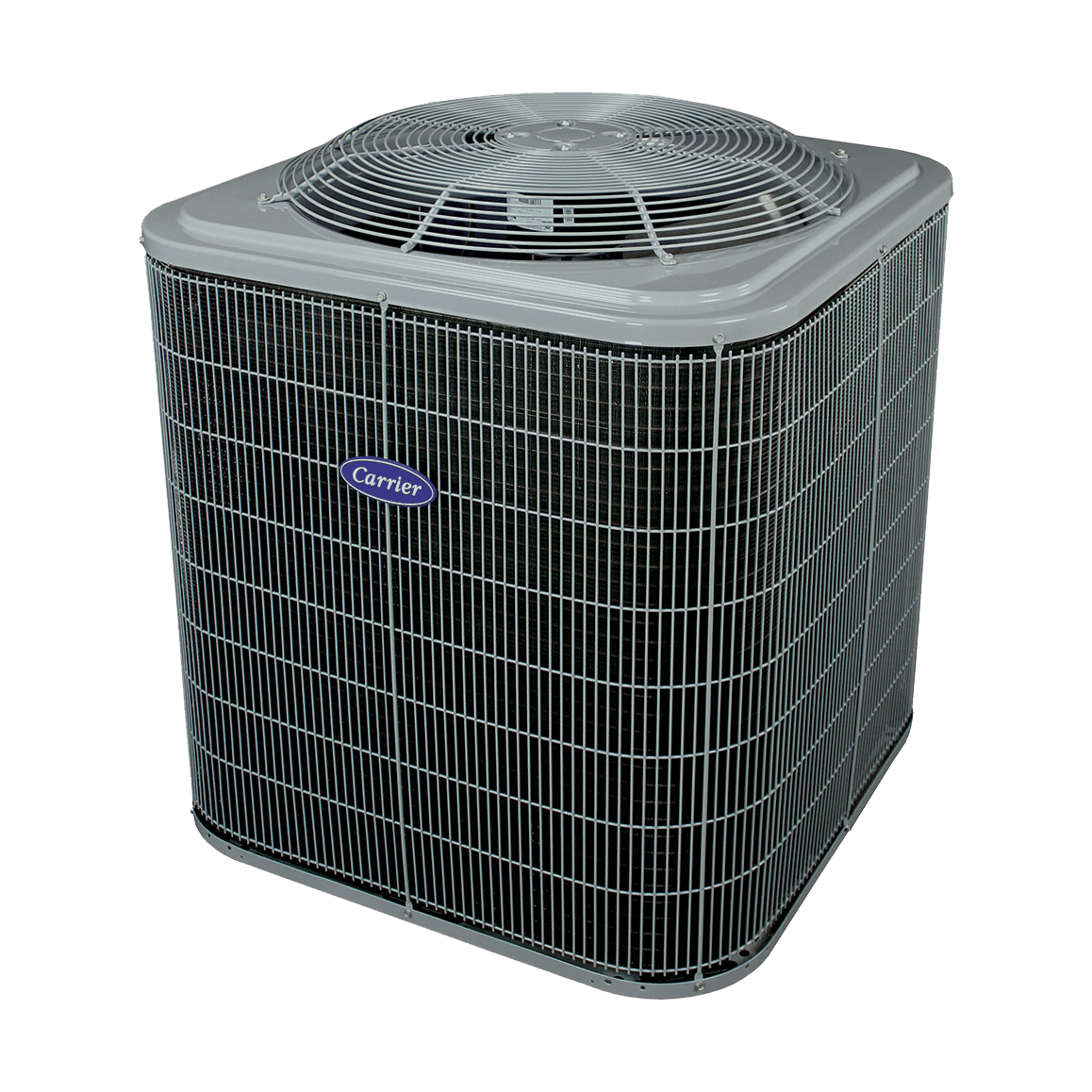Central Air Conditioner Prices
By Ryan Mayes
While air conditioners generally last quite a few years, most homeowners like you will eventually decide that it’s time for a new air conditioning unit. And when that time comes, there are typically a number of new technologies and overall quality and performance improvements that have been made since the previous central air conditioner installation.
Naturally, average costs for a new air conditioner will be one of your first questions. Air conditioner costs typically range between $3,000 - $15,000 or more. It’s important to note that this price range is an average and doesn’t include the cost of installing a furnace, evaporator coil or making modifications to ductwork which will all incur additional expenses. Additionally, there are other factors that can impact the cost like size, efficiency, and additional comfort features. We will break down the factors that influence central air conditioner prices, the differences between other AC unit costs and installation prices to help you make the best informed decisions with Carrier.
Factors THAT IMPACT COST OF NEW AC UNIT IN 2025
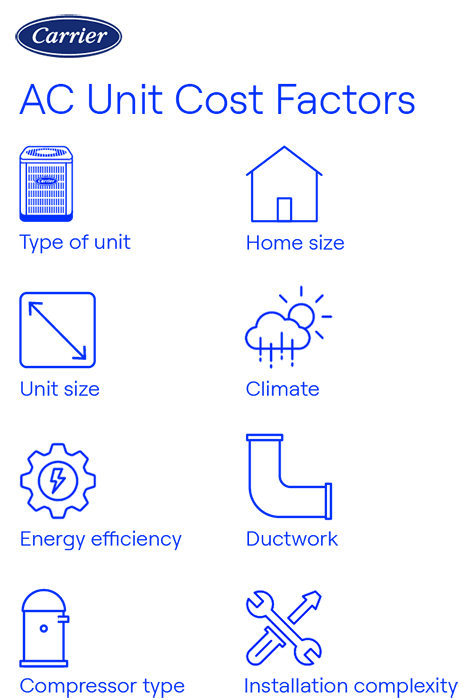
There are a number of factors that can influence the purchase price of new central air units.
- Type of unit: The type of unit, such as central air, ductless mini-split, or window units, can significantly impact the cost of a new AC system. Central air units, which require ductwork and complex installation, generally cost more than ductless systems or window units, which are typically easier and less expensive to install.
- Unit size and capacity: The size and capacity of a new air conditioner significantly impacts its cost, as larger units designed to cool bigger spaces generally come with higher price tags due to increased materials and more powerful components. Additionally, properly sizing the unit ensures efficiency and effectiveness, which can also affect overall operating costs. Learn more about finding the best size of an air conditioner.
- Energy efficiency: Higher efficiency AC models generally come with a higher upfront price due to the use of more advanced and costly components. While these units require a larger initial investment, they can lead to significant long-term savings on energy bills.
- Compressor Type: The type of compressor in a central AC unit impacts its cost, with single-stage compressors being the most affordable, two-stage compressors costing more due to their enhanced performance, and variable-speed compressors being the most expensive due to their advanced technology and superior efficiency. Each type offers different levels of comfort and energy savings, affecting the overall investment.
- Home Size: The size of your home directly affects the cost of a new AC unit, as larger homes require more powerful and often more expensive units to effectively cool the space. A properly sized unit ensures optimal performance and energy efficiency, influencing both the initial cost and long-term operating expenses.
- Climate & Region: The climate and region can impact the cost of a central AC unit, as areas with extreme temperatures or high humidity may require more robust and advanced systems, driving up the price.
- Existing Ductwork: The condition and configuration of existing ductwork can impact the cost of a new AC unit, as extensive repairs, modifications, or upgrades to the ductwork may be necessary to ensure proper airflow and efficiency. This additional work can increase the overall installation costs.
- Installation Complexity: The complexity of installing a central air unit can significantly affect its overall cost; intricate setups requiring extensive ductwork, electrical upgrades, or custom modifications can lead to higher labor and materials expenses. Additionally, challenging HVAC installations in hard-to-access areas or those that need specialized equipment or additional manpower also increase the final price.
- Additional Features: Incorporating advanced features into a new AC unit, such as smart thermostats, advanced air filtration systems, or zoning capabilities, can significantly raise the initial purchase price. These features require more sophisticated components and potentially complex installation processes, leading to higher overall costs, though they may provide enhanced comfort and energy efficiency in the long run.
Commercial HVAC systems are often larger and more expensive than residential air conditioning systems. The pricing and determining factors discussed in this article are geared toward residential heating and cooling systems for a typical single-family U.S. home that are installed using a qualified, professional cooling and heating system dealer.
HOW MUCH DOES A CARRIER AC UNIT COST?
Central AC unit cost will vary depending upon the model. For example, for Carrier, we offer three categories or tiers of air conditioners: Infinity®️ System, Performance™️ Series and Comfort™️Series. Infinity models include intelligent communicating technology for increased efficiency and comfort, and are typically higher priced than the mid-tier Performance models and the standard-tier Comfort units. However, each tier has a variety of technologies, efficiency ranges and price points. The best way to get accurate pricing is to contact your local Carrier dealer for an evaluation of your home and expert recommendations on models and systems to fit your needs and your budget.
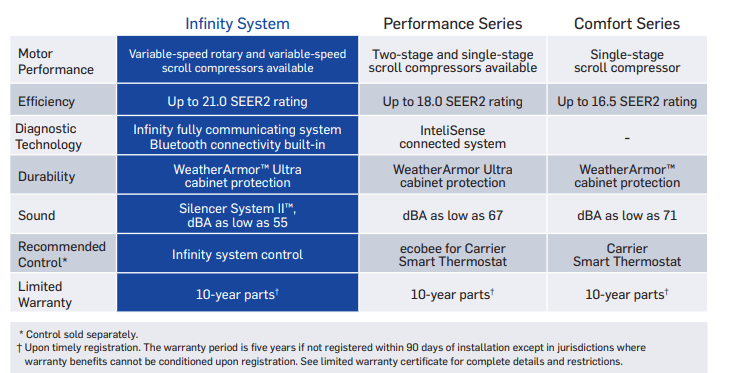
Carrier AC Unit Price by Type
The cost of air conditioners can vary widely based off the type of system. Below are rough estimates and include the full system like a furnace, evaporator coil or modifications to ductwork, all of which will increase the total cost. Additionally, some models could end up costing more money than outlined below, especially if your system requires additional labor, modifications, or complex installations. To get a more precise cost estimate, connect with your local Carrier expert to schedule an in-home consultation.
| Type | Cost Including Installation |
| Central air conditioning unit | $3,000 - $15,000 |
| Ductless mini split | $2,000 - $10,500 |
| Geothermal | $12,000 - $45,000 |

If you are looking for typical split air conditioning systems, there are still a number of determining factors. Just like buying a car, you can get into a basic economy model that will reliably get you from point A to point B... or you can get a top-of-the-line, luxury model with all the bells and whistles. Are you likely to look for a more basic central air conditioning unit that meets the minimum energy efficiency SEER2 rating? Or are you shopping for a unit that offers long-term energy savings with higher energy efficiencies and technology upgrades that supply better comfort and humidity control with quieter operation?
CARRIER ENERGY EFFICIENT AIR CONDITIONER FEATURES
Naturally, the higher end, higher performing units come with higher price tags. They also tend to be the models that qualify for utility company rebates or Federal tax credits for more energy efficient operation and reduced electrical usage. Carrier air conditioners offer a number of energy-saving and comfort-enhancing features to consider when you are getting estimates for a new HVAC system. Features available include:
- Communicating systems that work together to improve both comfort and energy efficiency
- Variable-capacity and modulating systems that deliver precise cooling loads based upon current conditions, and change as needed when conditions change
- Humidity-reducing technology to make you feel comfortable during hot, sticky days at higher indoor temperatures
- Sound-reducing features and functions that make your system whisper-quiet, outside and in
CARRIER CENTRAL AIR CONDITIONING UNIT PRICES FOR INSTALLATION
Due to the wide range of factors involved, determining central air installation cost is best done by contacting a reputable HVAC contractor in your area. The final price fluctuates based on a number of factors, including the local market, condition of the home and area climate. It also depends upon the type of system. Carrier air conditioners, for example, offer a variety of energy efficiency or SEER2* ratings, various types of comfort-enhancing technologies and even sound ratings. Installed costs might range from anywhere between $3,000 to $15,000 or more. As mentioned previously, these are rough estimates and don’t include an indoor unit like a furnace, evaporator coil, modifications to ductwork or other complex installations.
That’s quite a range! It’s important to note that while some people might be surprised by cost of a new air conditioner, there are numerous benefits to installing one. A new air conditioner is likely to be more efficient than your old unit and can help reduce your monthly cooling utility bills. Newer air conditioners can be quieter than older units, come with a warranty for peace of mind, and use refrigerants that offer lower global warming potential, thereby reducing environmental impact. Additionally, there are several ways to make central air unit prices more manageable, including promotional rebates at select times of year utility company rebates, HVAC financing options through your dealer, lease-to-own options and federal tax credits. To find out more, check out our dedicated rebate, Federal tax credit and and benefits of HVAC financing web pages.
In addition to the cost of the actual equipment, final installation costs will vary depending upon a number of factors. For example, a typical split-system central AC will require an indoor unit, an outdoor unit, ductwork and a thermostat. That means wiring, copper refrigerant tubing between the indoor and outdoor units, venting for the indoor unit if it’s a gas, propane or oil furnace, and other considerations. Also, are you updating to a new system in an older home, or is it a new construction installation? Are the existing refrigerant lines and ductwork usable or do they need to be replaced or repaired? Are you considering a zoned system? The answers to these questions all affect total pricing.
WHAT AFFECTS CARRIER AIR CONDITIONER COSTS FOR INSTALLATION?
When planning to install a new AC system, various factors play a crucial role in determining the overall cost. The type of AC system chosen—whether it's a simple AC replacement or an AC installation of a more complex system like a geothermal or packaged system—significantly influences the price. Additional elements such as the home's condition, including the quality of existing ducts, home layout, and regional climate, also impact the complexity and cost of the project. Understanding these variables helps in making well-informed decisions that align with both budgetary and comfort needs.

TYPE OF AIR CONDITIONING SYSTEM
One of the biggest factors determining the price of AC installation to expect will be what type of AC system is being installed or replaced. Are you simply replacing the AC unit only, or having an entirely new system installed? Is it a typical forced-air split system (AC unit outside, air handler unit inside) or are you going with a high efficiency geothermal system or a residential small packaged system (indoor and outdoor units, both in the same cabinet)?
The most basic least expensive installation is one that requires replacement of the outdoor split-system AC unit only. This job can be accomplished in 4 - 8 hours. If the both the outdoor unit and the indoor unit — likely a furnace or fan coil — need to be replaced, the job can be completed in 8 - 14 hours. Of course, the more time needed, the higher the installation costs. Geothermal systems require the additional cost of installing a ground loop which may include trenching or drilling in your yard. Small packaged systems combine both the indoor and the outdoor unit in one cabinet that sits outside, so installing a new unit on the ground and with existing ductwork is very straightforward. However, handling of the units can be tricky due to their size and weight, and in some areas, these units are installed on rooftops which can add another level of complexity – and cost.
Condition of the Home
Another factor that influences cost to install central air conditioning or other AC systems is the condition of the home and difficulty of the project. Home-related issues that can affect cost include:
- Home square footage
- Quality and amount of insulation, caulk and weather stripping
- Quality and condition of existing ducts
- Layout of the home (single-story, two-story, etc.)
- Number, quality and placement of windows
- Location/climate
- General condition of the home/quality of construction
All of the above and more can make the installation or replacement more labor-intensive for air conditioner contractors. For example, if the existing ductwork is undersized or in need of repair, your contractor may need to spend extra time sealing or replacing ductwork before completing the installation. Larger, multi-story homes may be better suited to a zoned system with two or more central AC units, or using supplemental ductless systems. Naturally, these systems will add cost for the additional units and any additional zone controls and duct dampers required. And, even a properly sized and installed air conditioner might struggle on hotter days if the home is poorly insulated and sealed.
Additionally, previous energy-saving modifications to the home, such as upgraded insulation, energy-efficient windows and even ENERGY STAR® qualified roofing may also reduce the peak cooling capacity requirements of the system that is required, potentially reducing cost.
Regional Climate
Regional climates can also influence central AC units prices.
In warmer climates: Your air conditioner will have a longer overall runtime during the cooling season compared to how it would operate in a more moderate climate. Installing a higher efficiency air conditioner system in a warmer climate home can help save money on monthly utility bills. However, keep in mind that higher efficiency systems tend to have higher central AC unit prices for the unit and installation. In some cases, your local utility or the U.S. government may have available rebates for installing air conditioners with high SEER2 (cooling efficiency) ratings. Higher efficiency units also tend to come with additional comfort features as well, so if you are more interested in comfort over energy efficiency, this might be the choice for you regardless of climate.
In cooler climates: Air conditioners in cooler climates will do just the opposite. There will be less calls for cooling, and therefore less overall runtime over the duration of the cooling season. In cooler climates, HVAC dealers may suggest a minimum efficiency unit to keep air conditioner costs in check. However, minimum efficiency units don’t offer the added comfort and lower operating sounds of the more deluxe models.
In moderate climates: Many manufacturers like Carrier offer mid-range units that strike a balance between higher efficiency and higher comfort operation and the bare-bones models. If you live in a more moderate area with periods of high temperatures, but potentially shorter or less intense cooling seasons than in the Deep South, these mid-tier offerings might be perfect for you. Mid-tier units might have two-stage cooling, higher SEER2 ratings than the more basic models, and some of the comfort-enhancing features found on higher end units. As you would expect, these models price out somewhere in the middle and often represent a great value in cooling comfort.

State of Existing Ducts
When you contact a reputable HVAC contractor for the cost to replace AC unit, they will likely do a complete assessment of your current system and your home. That inspection should include the existing ducts. Older ductwork that has leaks, is clogged, or hasn’t been properly sized for the needs of the system will affect the price of installation. To better assure that your new AC unit delivers the efficiency and comfort you expect and meets your overall satisfaction, your estimated installation costs will include the time and expense needed to make the necessary ductwork repairs. And, depending upon the severity of the issue(s), the labor and material costs can really add up. Prices for ductwork repair or AC duct cleaning will vary according to the amount and severity of the repair job.
CONTACT A CARRIER DEALER FOR INFORMATION ON CENTRAL AIR CONDITIONER PRICES
When contacting a local HVAC dealer about central air unit prices or HVAC replacement cost, be wary of those who are willing to give a quick quote over the phone. Every home and every homeowner is different, so every job will have unique pricing based on the technician’s expertise. Carrier has a nationwide network of highly qualified, independent dealers who can assess your home’s requirements, discuss your comfort preferences and deliver options for installing central air conditioning. To contact a dealer near you, go to the Carrier Dealer Locator and your local Carrier dealer can help you find the best air conditioner for your home.
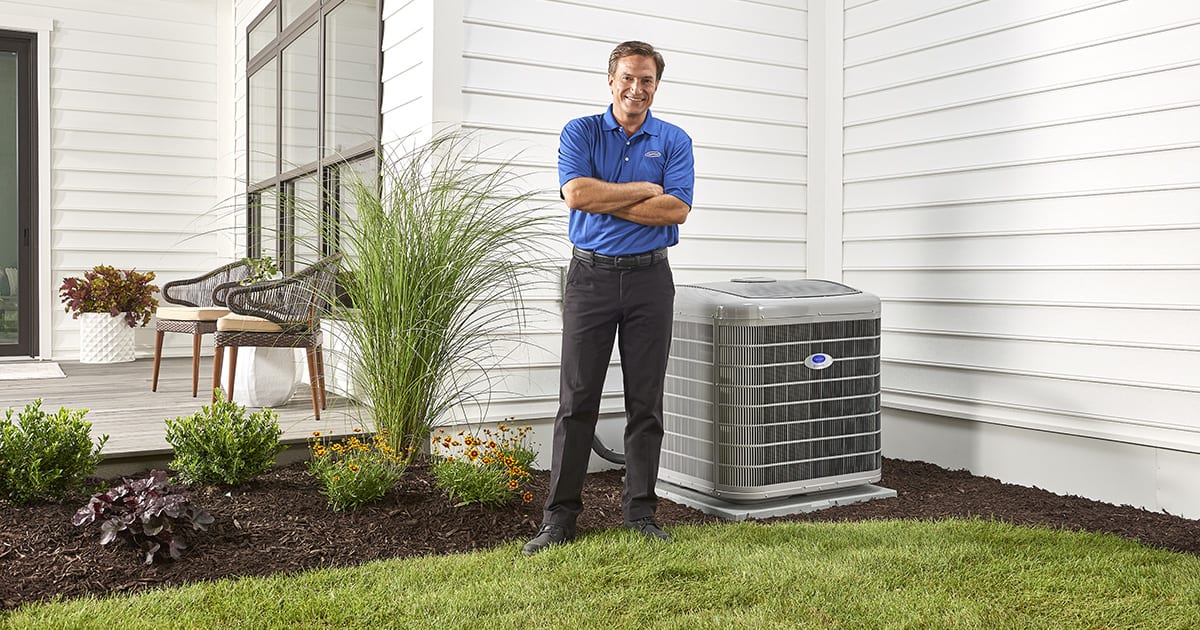
Explore Carrier Air Conditioners
Up to 21 SEER2 for premium energy savings with premium comfort features
Up to 16.5 SEER2 for enhanced energy savings with standard comfort features.
Up to 16.5 SEER2 for enhanced energy savings with standard comfort features.
Frequently Asked Questions About Central Air Conditioner Prices
Prices can vary based on local labor rates, unit size, energy efficiency ratings, and additional features. Installed costs for an outdoor unit alone might range from anywhere between $3,000 to $15,000 or more. For accurate pricing, it’s best to get a quote from your local Carrier dealer.
AC prices typically do vary by time of year. Air conditioners are usually purchased together with a heating unit as part of a central HVAC system. A matched system can improve energy efficiency and performance. Check with your local Carrier dealer for seasonal specials.
Learn More About Central Air Units
- Find out How Do Air Conditioners Work
- Learn about Air Conditioner Service
- Get details about an AC Tune Up
- Air Conditioner Maintenance tips
- In need of air conditioner parts or equipment?
- Explore the value of inverter air conditioners
